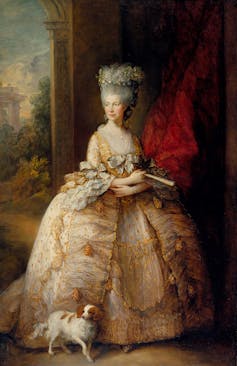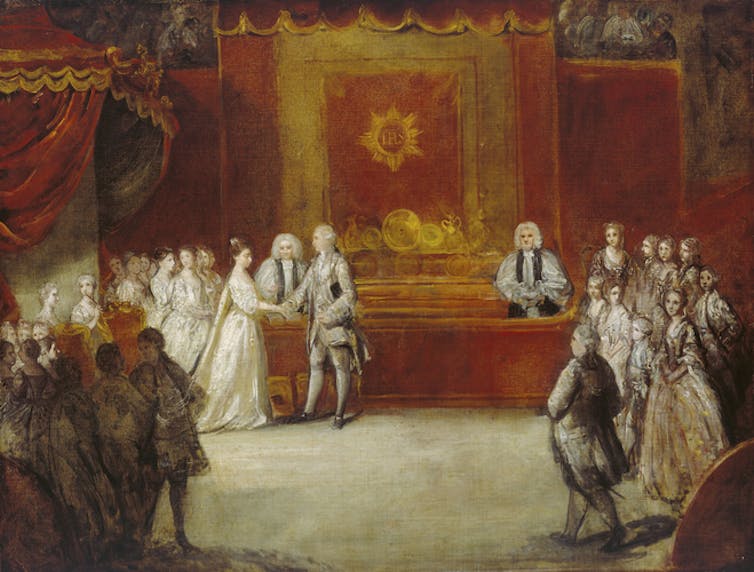Warning: the following article contains spoilers for Queen Charlotte: A Bridgerton Story.
Netflix’s period drama, Queen Charlotte: A Bridgerton Story, makes no pretence of historical accuracy. The opening credits state: “It is not a history lesson. It is fiction inspired by fact.” As a specialist on the Georgian monarchy who is writing a biography of Queen Charlotte, I was curious to see where fact and fiction meet in the show.
At the heart of the series is Charlotte’s relationship with her husband, King George III. In the first episode, Charlotte discovers that her marriage has been agreed to by her elder brother.
In the show, the teenage princess rails against the decision. The real Charlotte, in contrast, amazed her attendants with her calm and cheerful attitude, even in the face of a choppy sea crossing to England.
While the show exaggerates Charlotte’s angst, it is reasonable to assume that the 17-year-old princess felt trepidation at leaving her home in northern Germany, to which she would never return.

In the show, it is the king’s mother who chooses Charlotte as a match for her reluctant son. In reality, George III was heavily involved in the choice of his bride. On ascending the throne in 1760, aged 22, he immediately informed his ministers that he wished to marry.
A list of suitable candidates – young, Protestant and educated – was assembled and George scrutinised the reports on each of them. One was passed over for having a fondness for philosophy and another missed out because it was believed there was madness in her family.
The king ultimately decided on Princess Sophia Charlotte of Mecklenburg-Strelitz, who ticked all his boxes. George III was unconcerned that the young princess came from a minor royal family and that she had had a sheltered upbringing – he was just pleased to learn that she had an even temperament and no interest in politics.
The first meeting
As Netflix accurately shows, the first meeting between the young couple took place in a garden at St James’s Palace, the day after Charlotte arrived in England. They were married that evening, in a ceremony attended by the royal family and leading courtiers.

Charlotte’s wedding outfit was indeed splendid, but it was not chosen by her, as it is in the show. It had been made at the king’s command, along with an incredible trove of diamond and pearl jewellery.
In fact, the young queen’s wedding gown was so heavily encrusted with jewels that the bodice slipped down, revealing much of Charlotte’s chest to the guests.
Although not a love match, George and Charlotte’s relationship was a strong one from the beginning. At a ball following the wedding, the king told a courtier that he was “too happy” with his new queen.
The couple did not lead separate lives, as suggested in the Netflix show. Everywhere the king went, Charlotte followed. When the couple did begin living apart, in the early 1800s, it was due to the king’s severe mental decline.
By no means a perfect marriage, George III and Queen Charlotte embodied for many the ideal of a steady companionship built on mutual affection and shared values. Theirs was a largely successful partnership, but the king’s illness put intense strain on their relationship, as well as on Charlotte’s relationships with her children.
Charlotte the matriarch
One element of the show which does justice to the real Queen Charlotte is her position as matriarch of a large family. Having produced 15 children, 13 of whom lived to adulthood, Charlotte had more than fulfilled the requirement to produce heirs. As the king’s health wavered from 1789, Charlotte did her best to hold the family together in the face of many challenges.
In the “flash forward” sequences of the Netflix show, viewers see an older Queen Charlotte struggling to keep the monarchy and her family on track without the king. With the death of the Prince Regent’s daughter, Princess Charlotte, in 1817, the future of the monarchy looked uncertain.

While the fictional Charlotte seems indifferent to this tragedy, in reality the queen was devastated by her granddaughter’s death. The real Charlotte tried to assist her sons in finding suitable wives, but her own health was in decline. She died of heart failure in November 1818, just over a year after the death of her beloved granddaughter.
Charlotte’s position as matriarch was one which she maintained not for herself, but for the king. She constantly tried to steer the family in a direction of which the king would have approved, but in doing so, drove a wedge between herself and her children.

In the show, the Prince Regent accuses Charlotte of being more a queen than a mother to her own children. The fine balance of royal duty and motherhood was delicate enough, but the king’s illness made the real Queen Charlotte’s task even harder. Tragically, in his final illness, the king forgot most of his family, including his devoted queen.
There are many other areas in the show where historical fact is sacrificed on the altar of artistic license, but glimmers of the real Queen Charlotte shine through.
Those in search of a real history lesson on Queen Charlotte and the Georgians will have to look to the many books written by historians in recent years. Viewers may be pleasantly surprised to find that historical fact is often as interesting as fiction.





